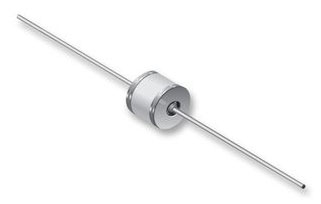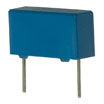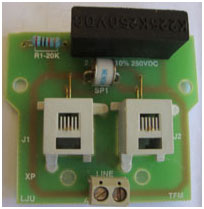Here is a simple circuit to protect TV from high voltage spikes during lightning or a power surge in the cable. It can be incorporated in the Coaxial cable of TV Antenna or Set top box. It uses a GDT and Safety capacitor to provide protection from high voltage spikes. The same circuit can also protect Cable Modem and Telephone lines.
Role of GDT
GDT is the Gas Discharge Tube, a surge protection device similar to MOV (Metal Oxide Varistor). It diverts the extra current from the hot line to the ground using an inert gas as the conductor between the two lines. It can be incorporated between the Core (Central conductor) and the Shield (Copper clad aluminium braid shield conductor) of the coaxial cable.

Fig. 1: Image of Gas Discharge Tube
GDT functions as an on/off switch with high impedance in the normal voltage conditions. Under surge condition, its internal gas ionizes to turn the device to a low impedance state called Arc mode or Short circuit. In this state the GDT conductsthe high voltage transients from hot line to the ground. Once the transient passes to the ground, the GDT returns to its high impedance state.
When the voltage through the cable is at a certain level, GDT will not conduct. When the voltage increases above this normal level due to a surge, the electrical power is strong enough to ionize the gas inside the GDT which act as a conductor to pass the high current to the ground until the voltage returns to the normal level. Again the GDT becomes a poor conductor.
The GDT used in the circuit is 2035-30, make 300 V 2 pole Arrester.
Role of Safety capacitor
A high voltage capacitor is also included in the circuit to withstand high impulsevoltage during surge. The capacitor will shunt the energy from the impulse to ground. Safety capacitors are available in ceramic disc and metalized film or paper. The film type are made of self-healing metalized polyester, polypropylene or paper and usually come in a “box” style casing as the capacitor is encased is a flame retardant or flame-proof case. The safety capacitor used in the circuit is 105 K 400 Volt DC.

Fig. 2: Image of a Safety Cap

Fig. 3: Image of TV Gaurd Circuit

Fig. 4: Image of Coaxial Cable
The components can be soldered lead-to-lead without a pcb. Enclose in a small plastic case and connect the circuit between the cable core and shield as shown in the diagram.
similar circuits are used in Telephone connector Box

Fig. 5: Image of Telephone connector Box
Filed Under: Circuit Design


Questions related to this article?
👉Ask and discuss on Electro-Tech-Online.com and EDAboard.com forums.
Tell Us What You Think!!
You must be logged in to post a comment.